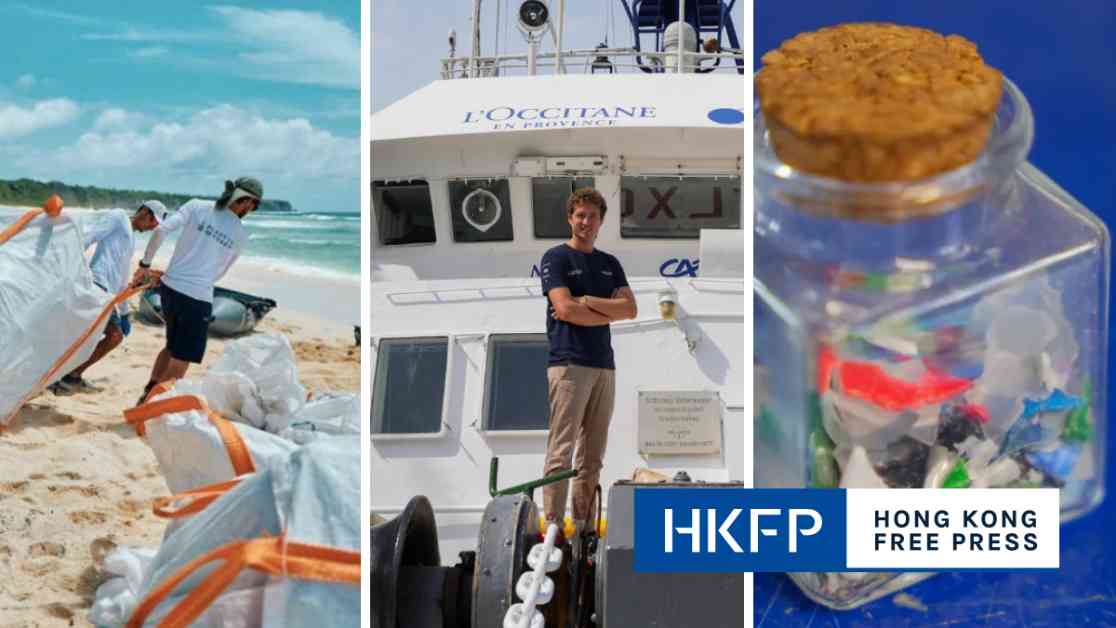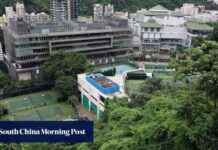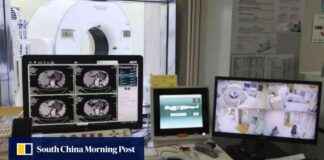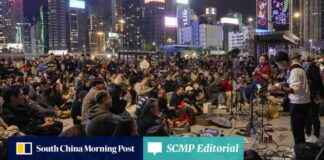A rising tide of plastic waste is choking our oceans, with 20 tonnes entering the sea every hour. Plastic has revolutionised our lives, but for decades experts have warned of the catastrophic consequences our over-reliance on this versatile and cheap material were having on the planet’s fragile ecosystems and biodiversity.
An upcoming United Nations-led Global Plastic Treaty offers hope in curbing relentless upward plastic production, yet substantial and irreversible damage has already been done. Plastic waste can take anywhere from 20 to 500 years to decompose, and even then, it never fully disappears. While halting the production of plastics is crucial, efforts are needed to repurpose the sheer volume of existing plastic waste globally – an estimated 8.3 billion tonnes.
An ocean expedition, led by French former merchant navy officer Simon Bernard and including a small team of engineers, sailors and communicators, is doing just that. On the water since 2022, the Plastic Odyssey crew are visiting the world’s 13 most polluted countries and regions, in Africa, South America and Southeast Asia. The mission? Identify where innovative, cheap and easily replicable plastic recycling solutions and alternatives exist, improve their efficiency, and distribute them in open-source across the world.
At every stopover, the team connects with communities to identify small-scale solutions at the local level. “We document small, locally-designed solutions that no one has heard of or talked about, in a sort of Wikipedia of all the knowledge on plastic recycling,” said Bernard. With the knowledge gained, they have established recycling courses and “fab labs” to educate on plastic pollution and recycling through webinars and workshops. At every stopover, they also offer incubation programmes to 10 and 15 entrepreneurs who are interested in setting up a recycling business.
While Bernard and his crew travel the world, a team of 15 engineers based in Senegal is building 10 small-scale “plug-and-play” plastic recycling factories inside containers using a franchise model. “We will have one model factory operated by the Plastic Odyssey team that local entrepreneurs will be able to replicate and operate independently,” Bernard said.
Tackling the crisis comes down to two things: cleaning up the past and building a future without plastic, Simon Bernard, CEO of Plastic Odyssey says. The factories, which will be ready next year, will process three to five tonnes of plastic per year and create 200 jobs, said Bernard. “The challenge will then be to replicate that in different countries.” “Our technique is low-tech, simple, and very different from the concept of recycling we know in Europe,” he said. “We are not trying to add to the vicious cycle of creating new packaging but instead we are focusing on how to store plastic into long-lasting products.” Their laboratories are powered by solar energy, which makes the whole process not only sustainable but also profitable for cash-strapped developing countries.
“It’s very tricky. We have to find the magic recipe to make it economically viable for poor countries without the need for more subsidies,” Bernard said. Without this approach, these solutions cannot be scaled up and have the impact needed to solve global plastic pollution, he added.
Bernard sat down with Earth.Org and HKFP’s photographer on a sunny October day. His crew was in Hong Kong for two weeks to meet entrepreneurs and find sponsors and investors. “It is very different here,” he said, indicating the view from the ship’s galley window. “We are used to a very different scenario. Here, it’s all tall buildings and shopping malls.” Accessing the ship, docked at Harbour City’s Ocean Terminal in Tsim Sha Tsui, was only possible through one of those shopping centres.
This, Bernard said, was a good example of how Hong Kong is contributing to the plastic crisis. Widespread consumerism is at the heart of the plastic pollution problem in the city, which every day sends an average of 15,725 tonnes of solid waste to landfills – 15 per cent of it plastic. Plastic has reached every corner of the city, polluting its waterways and contaminating the countryside. Small plastic fragments as seen aboard Plastic Odyssey on Wednesday, October 23, 2024. Photo: Kyle Lam/HKFP. Both investigations revealed that microplastics commonly found in single-use plastic packaging, takeaway containers, and disposable utensils – also known as polyethylene and polypropylene – were the predominant types found both in Hong Kong’s wild animal faeces and in its rivers.
In Hong Kong, and during every stopover, the crew has organised boat tours, film screenings, and small educational exhibitions for schools and educators to raise awareness about plastic pollution and give practical tips on how to live plastic-free. The two aspects of the Plastic Odyssey’s mission are also reflected in the structure of the boat. It is equipped with various low-tech, human-sized recycling and waste treatment machines – most of them built on board – and a workshop. But to fulfil the “other part of the equation” – reducing plastic consumption – the ship also offers dedicated areas to find and test viable alternatives. Wooden alternatives to plastics, aboard Plastic Odyssey on Wednesday, October 23, 2024. Photo: Kyle Lam/HKFP.
Tackling the global plastic crisis is a huge challenge and a matter of trial and error, Bernard said. But as one particular expedition proved, nothing is impossible. After months of preparation, in February the Plastic Odyssey team arrived on Henderson Island, an uninhabited UNESCO World Heritage site in the South Pacific. Henderson, one of the world’s last raised coral atolls, is also one of the most polluted places on earth. More than eight tonnes of plastic have washed up on its beaches, the highest density of plastic debris ever recorded. The 38-square-kilometre island has more than 38 million pieces of plastic on its shores, and conservative estimates suggest that anywhere between 3,500 to 13,500 new plastic items wash up on Henderson every day.
“Henderson was known to be impossible to clean up without damaging the coral reef that surrounds it,” said Bernard, explaining that several attempts had failed. In 2019, an expedition collected six tonnes of garbage on the eastern beach. But due to rocks and waves and the fragility of the coral reef, they were unable to take it away. When the Plastic Odyssey team reached the island, the bags of waste had deteriorated. “The trash was all over the island, we had to re-collect everything, from the bushes and in the sand, and repack everything,” said Bernard. But the team also achieved something that no one managed before.
Using rafts to transport the big trash bags to the ship and parasails when waves were too strong to use rafts, the 25-strong team successfully removed almost 10 tonnes of waste in just seven days. Back on the ship, they used on-board machinery to recycle the collected plastic into street furniture and other objects for the neighbouring island of Pitcairn. “It was quite special,” Bernard recalled, saying that the Henderson expedition marked the beginning of a new era for the Plastic Odyssey. “The idea is to partner with UNESCO and other international organisations to replicate what we have done in Henderson around the world.”
Next year, his team will head to Cape Verde in West Africa, which is also choking on plastic waste, to attempt a similar mission. “We spend all of our time meeting with incredible innovators, so it’s easy to be optimistic,” he said.



















